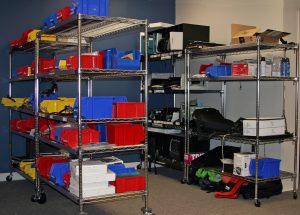
Assistive technology hardware and software, such as what is in our Technology Lending Center, comes many forms.
Back in July, we introduced a new series, Assistive Tech Tuesday. Every week, we have covered an interesting, noteworthy piece of assistive technology. Many of the examples we furnished are available to New Jersey residents for loan, free of charge, through our Technology Lending Center. As we mentioned in the first article of the series, this resource is the largest “lending library” for assistive technology in New Jersey. In addition, a number of the pieces we featured fit well within specific disability months. Assistive technology – the year in review. We look back upon what we featured, according to category.
Augmentative and Alternative Communication (AAC) Devices. These tools enables people who cannot express their ideas and feelings through speech to do so with the assistance of a machine and software that do the speaking.
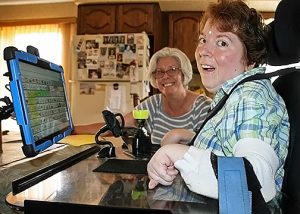
Tess C. relishes the new words and phrases she has learned on her new communication device, while Karren Gliniecki, Augmentative Communication
Specialist and speech-language pathologist in the Assistive Technology Services department.
Tess C. uses the highly versatile Accent 1400 to express her feelings and ideas, as well as to communicate with her many friends. Also helpful is Allora; like the Accent 1400, Allora a text-to-speech generating device with word-prediction capability to make it easier to use. This technology is also integral to the Proloquo line of apps that can be downloaded to a tablet or laptop computer.
For individuals new to AAC or have intellectual disabilities, there are two devices particularly worth mentioning. Partner/Plus makes AAC devices easier to learn and use, an excellent way to introduce the world of AAC to new users. For users who need an even simpler, easier-to-use system, there is the Talkable line, which use two or more large button switches, each to convey a specific message.
Though it is a contemporary with the likes of MS-DOS, Netscape, and Lotus 1-2-3, JAWS (Job AccessWith Speech) remains a popular and useful program. JAWS itself is a screen reader that translates words or graphics on a computer screen to an output device, such as a refreshable braille display or a speaker. Such technology is essential for blind people. It can be used in school, such as with Tyion L., or on the job, such as with Wayne K. and Steve R., both of whom are not only working, but also entrepreneurs.
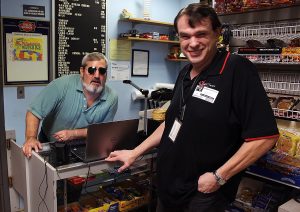
Wayne Kean (LEFT) operates a coffee shop in one of the state’s office buildings in Camden, NJ. Since he has a condition that has left him blind, he uses assistive technology to help keep track of inventory and work on his computer.
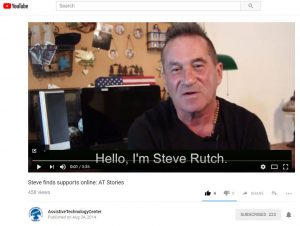
Assistive Technology for the blind helps Steve pursue his passion for sports and his business.
Some of our clients include Dave Finn, who can participate in and share his love of golf, well beyond the limits of the wheelchair he uses because of his muscular dystrophy.
Assistive Technology to Help Students with Disabilities Succeed in School and College. Dyslexia often poses a major challenge to otherwise bright students who have difficulty with visual word decoding. Livescribe 3 and Echo Smartpens are examples. These amazing gadgets, not much larger than an old-fashioned fountain pen can scan text on a page or record a teacher’s or professor’s presentation and play it back.
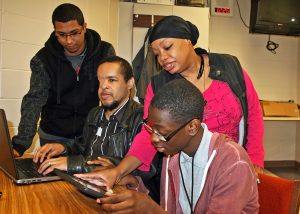
Tyion L., a blind high school student, receives hands-on assistance from Paul Day, Assistive Technology Specialist. Also present is his high school aide.
Software has played a big part in helping college students with dyslexia succeed in school. Brian M. uses the Kurzweil 3000, a downloadable text-to-speech app. Another student, Abby, also uses the Kurzweil 3000, along with programs such as Ginger and WordQ to assist with spelling for reading and writing.
Among the individuals who have benefited from this technology are Travis D., student with cerebral palsy, Tyion L., a blind high school student using refreshable braille displays, and Abby, a college student with dyslexia. Stephanie T., a blind woman who is now able to translate American Sign Language into English speech, thanks to Dragon NaturallySpeaking, a program that has helped Melissa and Kelly, two other clients. Some of these tools are like AAC “in reverse,” assistive tech to help an individual receive the written word.
Switches that Activate Other Machines. These devices are switches for individuals lacking fine-motor coordination, such as many people with cerebral palsy. Switches of all types allow the person to use his or her hand or head to activate another piece of assistive technology; they come in many forms.
So-called jellybean switches have been around for a while; most are simple, low-tech devices. (The Talkable line, described earlier, is another example.) However, a relative newcomer uses high-tech Bluetooth wireless technology to provide the individual with access to other high-tech devices, such as AAC hardware and applications. This is the AbleNet Blue2 switch.
Assistive Tech for Everyday Living. Donna M., a mother of three who suffers from the effects of a traumatic brain injury, uses smartphone and tablet computer apps to remind her of tasks she needs to accomplish during her busy schedule. AT Specialist Kristen Russell said, “For most of us, using smartphones and tablets and computers makes our lives easier, but for people with traumatic brain injury, it makes things possible.” Another example is the Amazon Echo, along with its counterpart, Google Home.
Now that we have reflected on these devices and apps, it’s time to look ahead to the many promises the future holds. That, after all, is what assistive technology is about!

Assistive Technology – A Year in Review


